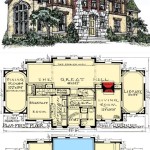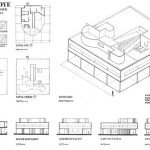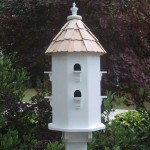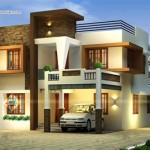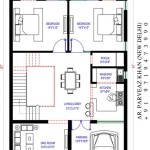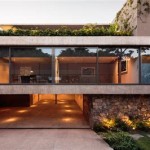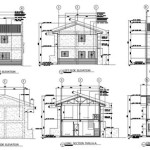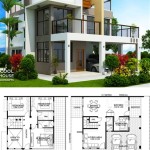House Plans: Mastering the Master Bedroom Design
The master bedroom, often considered a sanctuary within the home, requires careful planning during the house design phase. More than simply a place to sleep, it serves as a private retreat where individuals can relax, recharge, and prepare for the day. Effective house plans prioritize the master bedroom's functionality, aesthetics, and overall comfort, influencing not only the homeowner's daily life but also the property's overall value.
Consideration must be given to the bedroom's size, layout, natural light, and integration with adjacent spaces such as the master bathroom and walk-in closet. The design should reflect the homeowner's lifestyle and preferences, promoting a sense of tranquility and well-being. This article explores key aspects of master bedroom design within the broader context of house plans, highlighting crucial factors that contribute to a successful and fulfilling living space.
Optimizing Space and Layout
One of the most critical aspects of master bedroom design is the efficient utilization of space. A well-planned layout maximizes functionality and enhances the sense of spaciousness, even within a smaller footprint. This involves careful consideration of furniture placement, traffic flow, and the integration of functional zones within the room.
The bed is, of course, the focal point, and its positioning significantly impacts the room's overall feel. Generally, placing the bed against the longest wall offers stability and allows for better access to both sides. The headboard should be visually appealing and proportionate to the room's size. Nightstands, equipped with adequate lighting and storage, should flank the bed for convenience.
Beyond the core sleeping area, consider incorporating a seating area for reading or relaxation. This could include a comfortable armchair or a small loveseat placed near a window, creating a dedicated space for leisure. Similarly, a dressing area with a full-length mirror and a vanity can be incorporated into the layout, particularly if the walk-in closet is not directly adjacent to the bedroom.
Traffic flow is another essential consideration. Ensure that there is ample space to move freely around the bed and other furniture without feeling cramped. Avoid placing furniture in doorways or pathways that could obstruct movement. The goal is to create a layout that is both functional and aesthetically pleasing, promoting a sense of calm and order.
Consider the shape of the room when planning the layout. Rectangular rooms are generally easier to furnish, but other shapes, such as square or L-shaped rooms, can also be successfully designed with careful planning. In irregularly shaped rooms, focus on creating distinct zones to define the different functions within the space. For example, an L-shaped room could be divided into a sleeping area and a separate seating area, each with its own distinct character.
Built-in storage solutions, such as custom shelving or window seats with storage, can be incorporated into the design to maximize space and minimize clutter. These features not only provide practical storage but also add architectural interest to the room.
Integrating Natural Light and Ventilation
Natural light and ventilation play a crucial role in creating a comfortable and healthy master bedroom environment. Ample natural light can brighten the space, improve mood, and reduce the need for artificial lighting during the day. Proper ventilation helps to circulate fresh air, reducing humidity and improving air quality.
When designing the master bedroom, prioritize the placement of windows to maximize natural light. Large windows, preferably facing east or south, can capture the morning sun and provide ample illumination throughout the day. Consider incorporating multiple windows on different walls to create a more balanced and even distribution of light.
Window treatments, such as blinds, curtains, or shades, are essential for controlling the amount of light entering the room. Blackout curtains can be used to create a dark and restful sleep environment, while sheer curtains can filter the light and provide privacy without completely blocking the view. The choice of window treatments should depend on the homeowner's preferences and the orientation of the windows.
Ventilation is equally important for maintaining a healthy indoor environment. Windows that can be opened and closed are essential for allowing fresh air to circulate. Consider incorporating transom windows or skylights to provide additional ventilation, particularly in areas with limited wall space. Ceiling fans can also be used to improve air circulation and reduce the need for air conditioning.
The placement of windows should also consider privacy. Avoid placing windows directly facing neighboring properties or busy streets. Consider using landscaping or architectural features to create a buffer between the bedroom and the outside world. Frosted glass or privacy film can also be used to provide additional privacy without sacrificing natural light.
The orientation of the master bedroom within the house plan should also take into account the sun's path. East-facing bedrooms receive morning sun, while west-facing bedrooms receive afternoon sun. The choice of orientation should depend on the homeowner's preferences and the climate. In warmer climates, it may be preferable to have a bedroom that faces east to avoid excessive afternoon heat.
Designing for Accessibility and Aging in Place
Designing a master bedroom that is accessible and adaptable for aging in place is becoming increasingly important, as homeowners seek to remain in their homes for longer. This involves incorporating features that enhance mobility, safety, and convenience, ensuring that the bedroom remains a comfortable and functional space for years to come.
One of the most important considerations is the width of doorways and hallways leading to the master bedroom. Wider doorways, at least 36 inches wide, allow for easier access for individuals using wheelchairs or walkers. Similarly, hallways should be wide enough to accommodate mobility aids without feeling cramped.
The design of the master bathroom should also prioritize accessibility. A walk-in shower with a low threshold or no threshold is essential for individuals with mobility limitations. Grab bars should be installed in the shower and near the toilet to provide additional support. A comfort-height toilet, which is slightly taller than a standard toilet, can also make it easier for individuals to sit and stand.
Adequate lighting is crucial for safety and visibility. Install bright, even lighting throughout the bedroom and bathroom, paying particular attention to areas where falls are more likely to occur, such as near the bed and in the shower. Consider using motion-sensor lighting that automatically turns on when someone enters the room.
Flooring materials should be slip-resistant to minimize the risk of falls. Avoid using highly polished surfaces or loose rugs that could create a tripping hazard. Consider using carpeting with a low pile or resilient flooring with a textured surface.
The height of the bed should also be considered. A bed that is too low or too high can be difficult to get in and out of. The ideal bed height is typically around 20 to 23 inches from the floor to the top of the mattress.
Finally, consider incorporating smart home technology to enhance convenience and security. Voice-activated lighting, temperature control, and security systems can make it easier for individuals to manage their home environment and stay safe.
By incorporating these accessibility features into the master bedroom design, homeowners can create a space that is both comfortable and functional for individuals of all ages and abilities. This not only enhances the homeowner's quality of life but also increases the property's long-term value.
Ultimately, a well-designed master bedroom is a reflection of the homeowner's personal needs and preferences. By carefully considering the factors outlined above – space and layout, natural light and ventilation, and accessibility – it is possible to create a master bedroom that is both a sanctuary and a functional space for years to come. The integration of these elements contributes significantly to the overall success of the house plan and the homeowner's satisfaction.

Plan 58551sv Three Master Bedrooms Country House Plans Floor

Master Bedroom Floor Plans Types Examples Considerations Cedreo

Master Bedroom Floor Plans An Expert Architect S Vision

How To Design A Master Suite Feel Luxury

Master Bedroom Floor Plans An Expert Architect S Vision

Master Bedroom Floor Plans Types Examples Considerations Cedreo

Extra Large Master Suite 6552rf Architectural Designs House Plans

9 Tips To Consider When Planning Your Bedroom Layout

Plan 69691am One Story House With Two Master Suites Plans New 2 Bedroom

How To Design A Master Suite Feel Luxury

